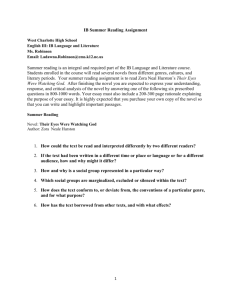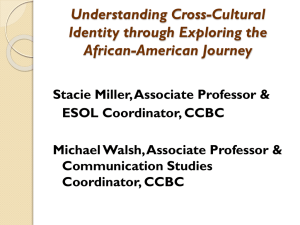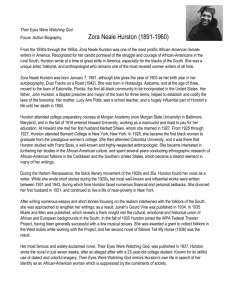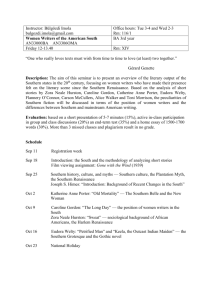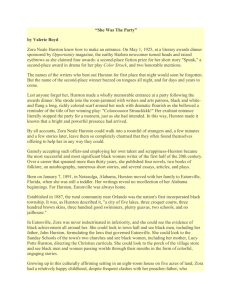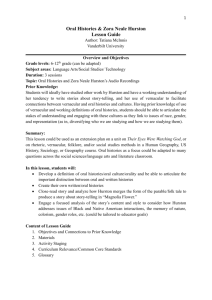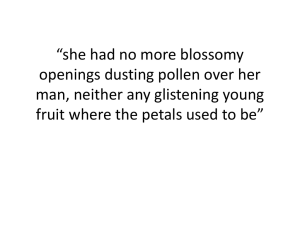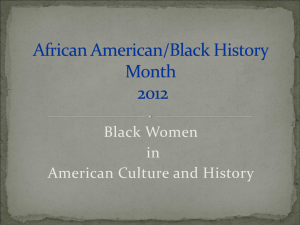Nora Zeale Hurston Biography & Handout
advertisement
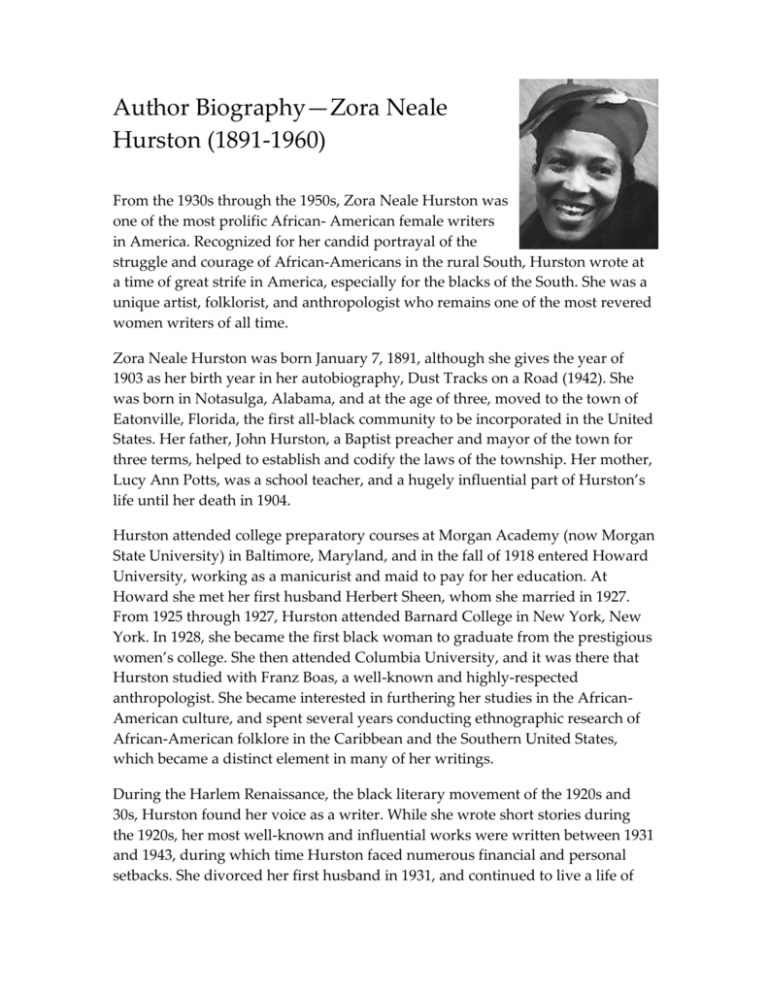
Author Biography—Zora Neale Hurston (1891-1960) From the 1930s through the 1950s, Zora Neale Hurston was one of the most prolific African- American female writers in America. Recognized for her candid portrayal of the struggle and courage of African-Americans in the rural South, Hurston wrote at a time of great strife in America, especially for the blacks of the South. She was a unique artist, folklorist, and anthropologist who remains one of the most revered women writers of all time. Zora Neale Hurston was born January 7, 1891, although she gives the year of 1903 as her birth year in her autobiography, Dust Tracks on a Road (1942). She was born in Notasulga, Alabama, and at the age of three, moved to the town of Eatonville, Florida, the first all-black community to be incorporated in the United States. Her father, John Hurston, a Baptist preacher and mayor of the town for three terms, helped to establish and codify the laws of the township. Her mother, Lucy Ann Potts, was a school teacher, and a hugely influential part of Hurston’s life until her death in 1904. Hurston attended college preparatory courses at Morgan Academy (now Morgan State University) in Baltimore, Maryland, and in the fall of 1918 entered Howard University, working as a manicurist and maid to pay for her education. At Howard she met her first husband Herbert Sheen, whom she married in 1927. From 1925 through 1927, Hurston attended Barnard College in New York, New York. In 1928, she became the first black woman to graduate from the prestigious women’s college. She then attended Columbia University, and it was there that Hurston studied with Franz Boas, a well-known and highly-respected anthropologist. She became interested in furthering her studies in the AfricanAmerican culture, and spent several years conducting ethnographic research of African-American folklore in the Caribbean and the Southern United States, which became a distinct element in many of her writings. During the Harlem Renaissance, the black literary movement of the 1920s and 30s, Hurston found her voice as a writer. While she wrote short stories during the 1920s, her most well-known and influential works were written between 1931 and 1943, during which time Hurston faced numerous financial and personal setbacks. She divorced her first husband in 1931, and continued to live a life of near-poverty in New York. After writing numerous essays and short stories focusing on the realism intertwined with the folklore of the South, she was approached to lengthen her writings; as a result, Jonah’s Gourd Vine was published in 1934. In 1935 Mules and Men was published, which reveals a frank insight into the cultural, emotional and historical union of African and European backgrounds in the South. In the fall of 1935 Hurston joined the WPA Federal Theater Project, having been generally successful with a few musical revues. She was awarded a grant to collect folklore in the West Indies while working with the Project, and her second novel of folklore Tell My Horse (1938) was the result. Her most famous and widely-acclaimed novel, Their Eyes Were Watching God, was published in 1937. Hurston wrote the novel in just seven weeks, after an alleged affair with a 23-year-old college student. Known for its skillful use of dialect and colorful imagery, Their Eyes Were Watching God mirrors Hurston’s own life in search of her identity as an African-American woman which is suppressed by the constraints of society. In 1939, Hurston became a drama instructor at North Carolina College for Negroes, published Moses, Man of the Mountain, and married her second husband, Albert Price II (whom she divorced a year later.) She wrote her autobiography Dust Tracks on a Road in 1942, and in 1948, the controversial Seraph on the Suwanee, which was about a white woman searching for her own sense of self. After suffering numerous setbacks, including the allegation of committing an immoral act with a minor (which was later dropped), Hurston returned to a life of poverty. In 1950, she was spotted working as a maid in Florida. She also worked as a librarian at Patrick Air Force Base and as a substitute teacher at Lincoln Park Academy from 1956-1958. After suffering a stroke in 1959, Hurston was forced to move into St. Lucie Welfare Home. Hurston died at the home, penniless and nameless, on January 28, 1960. She was buried in an unmarked grave until 1973, when writer Alice Walker discovered and inscribed her gravestone with “Zora Neale Hurston A Genius of the South 1901-1960 Novelist, Folklorist, Anthropologist.” Walker alone is credited with sparking a revival and new appreciation of Hurston’s works in 1975 with her article “In Search of Zora Neale Hurston,” which was featured in Ms. magazine. Exploring Expository Writing: Zora Neale Hurston Biography Directions: Use the biography of Zora Neale Hurston on page 7 to answer the following questions. Write the letterof the correct answer on the line provided. 1. _______ What is the author’s purpose for writing this biography about Zora Neale Hurston? a. To persuade the reader to read Hurston’s plays b. To describe Hurston’s home life while growing up c. To inform the reader about Hurston’s life and works d. To entertain the reader before reading Hurston’s plays 2. _______ Based upon the information given in paragraph 2, the reader can assume that: a.Hurston was a talented and respected writer. b. There was a discrepancy about her birth date. c. Hurston didn’t want anyone to know where she grew up. d. The 1900 census records are inaccurate. 3. _______ Which of the following happened at the same time that Hurston wrote many of her most well- known works? a.Hurston was accused of molesting a ten-year-old boy. b. Hurston moved to Africa. c. The Harlem Renaissance was in its prime. d. Huston met her first husband, Herbert Sheen. 4. _______ In which paragraph would it be most appropriate to insert information about Hurston’s connection with Mrs. Rufus Osgood, a white patron who funded part of Hurston’s ethnographic work? a. paragraph 1 or 5 b. paragraph 2 or 6 c. paragraph 3 or 5 d. paragraph 4 or 7 Read the following sentence to answer Question 5: Hurston died at the home, penniless and nameless, on January 28, 1960. 5. _______ Which word or words would best replace the underlined word in the sentence above to make the sentence more precise? a. unknown b. memorialized c. demoralized d. revered 6. _______ Which of the following would be least likely to fit in the article about Hurston? a. A paragraph highlighting Alice Walker’s writings. b. A paragraph about the history of Florida. c. A paragraph about Hurston’s work in college. d. A paragraph about the Harlem Renaissance and its most prolific and influential writers. 7. _______ Which of the following questions would be most appropriate to ask Hurston if you were a reporter who had been granted an interview with her? a. How has your own life influenced the development of the characters in your writings? b. Have you ever met Langston Hughes? c. Why did you file for divorce from your second husband within a year of your marriage? d. What is it like being poor? 8. _______ Based upon the information in this article, what do you think the word prolific means (from paragraph 1)? a. wealthy b. productive c. talented d. caustic
